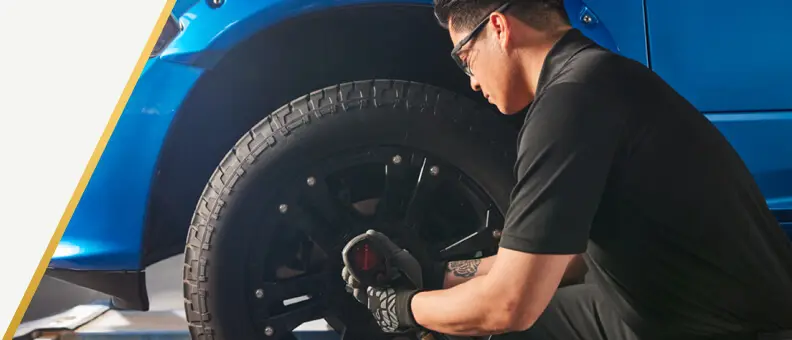Wheel Alignment & TIRES
What does wheel alignment do?
Wheel alignment (also known as tire alignment) is a service that adjusts your vehicle’s suspension to ensure that all wheels are oriented correctly in relation to each other and to the road. In practical terms, wheel alignment ensures that every wheel points in the same direction and every tire maintains optimal contact with the road. It also helps maximize your tire investment by preventing some kinds of uneven tire wear.
The wheel alignment process involves measuring and restoring the factory settings of three angles in your vehicle’s suspension:
- The Camber angle: The vertical tilt of the side of the wheel in relation to the side of the vehicle, viewed from the front or back of the vehicle.
- The Caster angle: The tilt of the steering axis in relation to a theoretical vertical straight line, viewed from the side of the vehicle.
- The Toe angle: The lateral tilt of the side of the wheel in relation to the center of the vehicle, viewed from above the vehicle.
Wheel alignment involves meticulous measurements on an alignment machine. It’s a job for a qualified mechanic using precision equipment. And that’s what you’ll find at your local Shop.
How do you know you need a wheel alignment?
When your vehicle needs wheel alignment, you may notice these symptoms in your steering wheel and tires:
- Rolling to the right or left: While pointing your steering wheel straight ahead on a level road.
- Crooked steering wheel: You’re driving straight ahead, but your steering wheel looks as if you’re making a turn.
- Tire noise: As the misaligned tires are dragged in a different direction than they’re pointed toward.
- Uneven tire wear: You see one of these telltale tread patterns: Diagonal wipe, feathering, camber wear, or toe wear. Or, you notice a mismatch in tread wear between the two front tires or the two back tires.

TIRES
-
You should replace any tire that shows one or more of these signs of age, damage, or wear:
- Low tread depth: Replace tires that have worn down below the recommended tread depth. The U.S. legal minimum tread depth is 2/32.” You may want to replace your tires at a higher tread depth depending on manufacturer recommendations, or your specific driving conditions.
- Sidewall damage: Tires with cracks, punctures, blisters, or bulges in the sidewall are no longer structurally sound and cannot be repaired.
Your local Dong Peng technician can help you identify these tire safety hazards, and help you select your perfect replacement tires.
At what tread depth should tires be replaced?
The legal minimum tire tread depth in the United States is 2/32” and many tire experts recommend replacing tires at 4/32”-6/32” tread depth or less, especially for tire types that benefit from a deeper tread (snow tires, all-terrain tires, or mud tires). Testing multiple winter tire brands at 5/32”-6/32” tread depth (or 50% of original tread depth), Consumer Reports saw a 14.5% decline in snow traction when accelerating, and a 7% increase in wet stopping distance compared to the tires’ original tread depth2tread footnote reference – same page.
How to tell if your tire tread depth is too low, and you need to replace your tires:
- Use a tire tread depth gauge for a precise measurement.
- Take the U.S. Penny Test: Insert a penny (head first) into your tire tread. If you can see the top of Lincoln’s head, it’s time for new tires. If the top of Lincoln’s head is covered, your tread is deeper than 2/32”. On the tail side, if the top of the Lincoln Memorial is covered, your tread is deeper than 6/32”.
- Take the Canadian nickel test: If the top of Queen Elizabeth’s crown is covered, your tread is deeper than 2/32”.
- Take the U.S. Quarter Test: If the top of Washington’s head is covered, your tire tread is deeper than 4/32”.
- Take the Canadian Quarter Test: If the caribou’s nose is covered, your tire tread is deeper than 6/32”.
- Check the wear bars: Tire wear bars are situated at 2/32” of tread depth, so if any wear bar is worn, replace the tire right away. It’s below the legal minimum tread depth.
Check tread depth on several parts of the tire, especially if you see uneven wear patterns. And talk to a Dong Peng tire expert to help you decide how low your tread depth can go.
